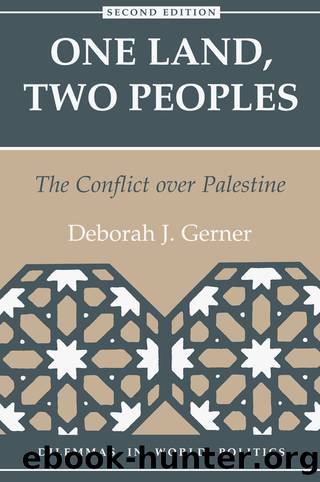One Land, Two Peoples: The Conflict Over Palestine by Deborah J. Gerner

Author:Deborah J. Gerner [Gerner, Deborah J.]
Language: eng
Format: epub
Tags: Middle Eastern, Social Science, Political Science, World, Regional Studies
ISBN: 9780429974540
Google: 8UdaDwAAQBAJ
Goodreads: 40140795
Publisher: Routledge
Published: 1990-10-29T00:00:00+00:00
Jordan, the Palestinians, and the Lebanese Civil War
At the end of the June 1967 War, Jordan became a home for thousands of new Palestinian refugees fleeing the Israeli occupation of the West Bank. Palestinian national identity was repressed, and relations between Jordanians and Palestinians were frequently tense. Many Palestinians looked down upon the Jordanian fighters for having lost the West Bank to Israel and pointed out that it was the Palestinian community, not the Jordanians, who suffered as a result of Jordanian failures. Members of some Palestinian groups, such as the PFLP, called for the overthrow of the Arab monarchies, including the Hashemite regime in Jordan, arguing that this was an essential first step toward the liberation of Palestine. Not surprisingly, these views did not endear the Palestinians to the Jordanian government or to the military. Jordanians also resented the economic stress placed upon their society by the increased Palestinian presence, and saw the well-educated and politically astute Palestinians as a threat to the positions of power held by Jordanians. Finally, there was widespread concern that the military activities of the Palestinian fighters against Israel would result in Israeli retaliatory military attacks against Jordan.
Jordanian fears became more pronounced after the 1960 Battle of Karameh. On 21 March Israel launched a massive attack on the Karameh refugee camp and Fateh guerrilla base located there. Although Palestinian troops, assisted by Jordanian forces, were outnumbered and took heavy casualties, they also inflicted severe losses on the Israeli forces, which had not expected such intense resistance. The Battle of Karameh provided a needed boost to the self-confidence of the Palestinians, and the number of volunteers joining the guerrilla movement multiplied dramatically. At the same time, the events at Karameh signaled the Arab world that the Palestinian resistance movement had become an autonomous factor in the conflict with Israel that could not easily be ignored.
With the increased number of guerrilla fighters, Palestinians gained greater power and influence within Jordan and began to develop a state-within-a-state over which the Jordanian monarchy had virtually no control. Thus, Palestinians were free to attack Israeli troops in the West Bank without restraint, and cross-border attacks by both Israelis and Palestinians became more frequent. By the summer of 1970, there was a high level of anxiety in Jordan, with Palestinians and Jordanians ready for confrontation. Nasser's decision in July to accept a U.S.-mediated cease-fire agreement with Israel exacerbated Palestinian unease. Palestinians interpreted this as an indication that the Arab states would forsake Palestinians if doing so would enhance their own interests.
The final impetus for the Jordanian-Palestinian War was the hijacking of four commercial airplanes by the PFLP in early September. Three of the planes were set down in the eastern desert of Jordan, where the PFLP held the passengers hostage in defiance of Jordanian efforts to negotiate their freedom. Although the passengers were eventually released, the challenge to King Hussein's authority was too much for him to tolerate, and on 17 September he gave the order for his military forces to attack the Palestinian guerrillas.
Download
This site does not store any files on its server. We only index and link to content provided by other sites. Please contact the content providers to delete copyright contents if any and email us, we'll remove relevant links or contents immediately.
| Bahrain | Egypt |
| Iran | Iraq |
| Israel & Palestine | Jordan |
| Kuwait | Lebanon |
| Oman | Qatar |
| Saudi Arabia | Syria |
| Turkey | United Arab Emirates |
| Yemen |
Empire of the Sikhs by Patwant Singh(22974)
The Wind in My Hair by Masih Alinejad(5033)
Rise and Kill First by Ronen Bergman(4701)
The Templars by Dan Jones(4627)
The Rape of Nanking by Iris Chang(4136)
12 Strong by Doug Stanton(3508)
Blood and Sand by Alex Von Tunzelmann(3138)
Babylon's Ark by Lawrence Anthony(2620)
The History of Jihad: From Muhammad to ISIS by Spencer Robert(2566)
No Room for Small Dreams by Shimon Peres(2318)
The Turkish Psychedelic Explosion by Daniel Spicer(2313)
Inside the Middle East by Avi Melamed(2305)
Gideon's Spies: The Secret History of the Mossad by Gordon Thomas(2303)
Arabs by Eugene Rogan(2260)
The First Muslim The Story of Muhammad by Lesley Hazleton(2217)
Come, Tell Me How You Live by Mallowan Agatha Christie(2212)
Bus on Jaffa Road by Mike Kelly(2101)
Kabul 1841-42: Battle Story by Edmund Yorke(1985)
1453 by Roger Crowley(1957)
